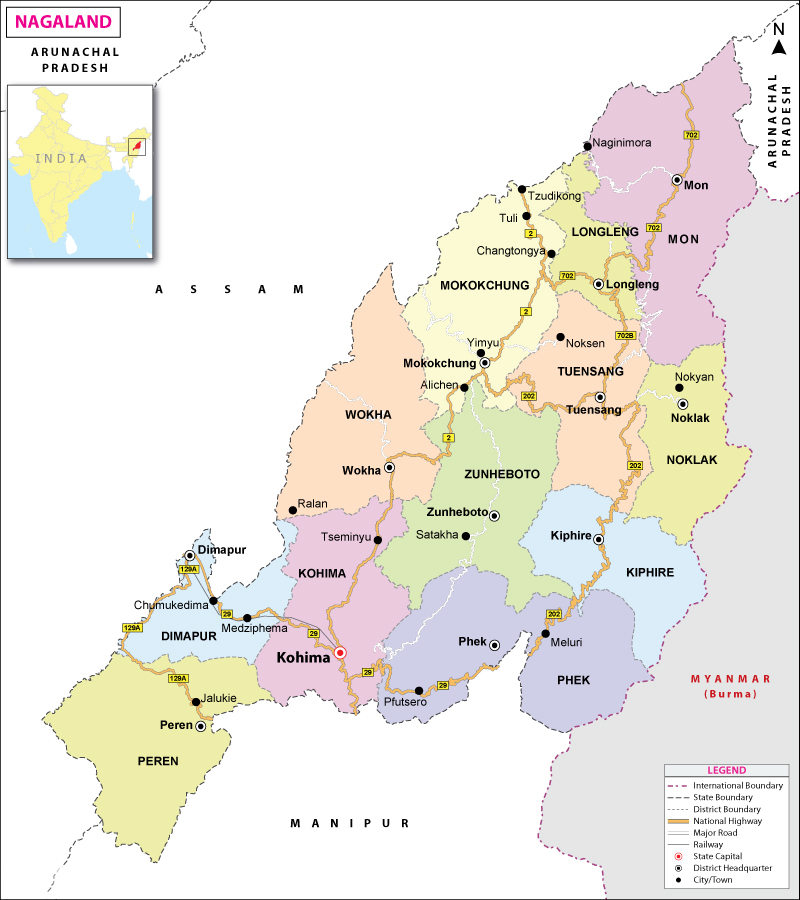Nagaland Statehood Day | 03 Dec 2021
Why in News
Recently, Nagaland has celebrated its 59th Statehood day on December 1st 2021.
- Nagaland was formally recognised as a separate state on 1st December, 1963, with Kohima being declared as its capital.
- The State of Nagaland Act, 1962, was enacted by the Parliament to give Nagaland statehood.
Nagaland
- Historical Background:
- After India became independent in 1947, the Naga territory initially remained a part of Assam. However, a strong nationalist movement began seeking a political union of the Naga tribes, and extremists demanded outright secession from the Indian union.
- In 1957, the Naga Hills region of Assam and the Tuensang frontier division to the northeast were brought together under a single unit directly administered by the Indian government.
- In 1960 it was resolved that Nagaland should become a constituent state of the Indian union. Nagaland achieved statehood in 1963, and a democratically elected government took office in 1964.
- Geography:
- It is bounded by the Indian states of Arunachal Pradesh to the northeast, Manipur to the south, and Assam to the west and northwest and the country of Myanmar (Burma) to the east. The state capital is Kohima, located in the southern part of Nagaland.
- Nagaland has a Monsoonal (wet-dry) Climate. Annual rainfall averages between 70 and 100 inches and is concentrated in the months of the southwest monsoon (May to September).
- Biodiversity:
- Flora: Forests cover about one-sixth of Nagaland. Below 4,000 feet are tropical and subtropical evergreen forests, containing palms, rattan, and bamboo, as well as valuable timber species. Coniferous forests are found at higher elevations. Areas cleared for jhum (shifting cultivation) have a secondary growth of high grass, reeds, and scrub jungle
- Fauna: Elephants, tigers, leopards, bears, several kinds of monkeys, sambar deer, buffalo, wild oxen, and the occasional rhinoceros live in the lower hills. Porcupines, pangolins (scaly anteaters), wild dogs, foxes, civet cats, and mongooses also are found in the state.
- Mithun (Gayal) is the state animal of Nagaland and Arunachal Pradesh.
- Blyth's tragopan is the state bird of Nagaland.
- Tribes:
- The Konyaks are the largest tribe, followed by the Aos, Tangkhuls, Semas, and Angamis.
- Other tribes include the Lothas, Sangtams, Phoms, Changs, Khiem Hungama, Yimchunger, Zeliangs, Chakhesangs (Chokri), and Rengmas.
- Economy:
- Agriculture employs about nine-tenths of the population. Rice, corn (maize), small millets, pulses (legumes), oilseeds, fibres, sugarcane, potato, and tobacco are the principal crops.
- Nagaland, however, still has to depend on imports of food from neighbouring states.
- Protected Areas in Nagaland:
- Intanki National Park
- Singphan Wildlife Sanctuary
- Puliebadze Wildlife Sanctuary
- Fakim Wildlife Sanctuary
- Major Festival:
- The Hornbill Festival is a celebration held every year from 1 to 10 December, in Nagaland.
- The significance of the festival lies in the fact that it is not an ancient festival, and it was started in the year 2000 to popularise Nagaland among the tourists.
Nagas
- Nagas are a hill people who are estimated to number about 2.5 million (1.8 million in Nagaland, 0.6 million in Manipur and 0.1 million in Arunachal states) and living in the remote and mountainous country between the Indian state of Assam and Burma.
- There are also Naga groups in Burma.
- The Nagas are not a single tribe, but an ethnic community that comprises several tribes who live in the state of Nagaland and its neighbourhood. Nagas belong to the Indo-Mongoloid Family.
- There are nineteen major Naga tribes, namely, Aos, Angamis, Changs, Chakesang, Kabuis, Kacharis, Khain-Mangas, Konyaks, Kukis, Lothas (Lothas), Maos, Mikirs, Phoms, Rengmas, Sangtams, Semas, Tankhuls, Yamchumgar and Zeeliang.

